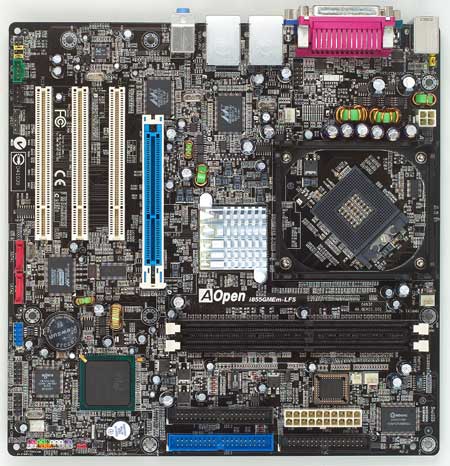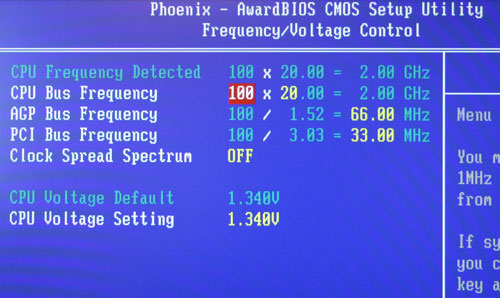Intel's Pentium M on the Desktop - A Viable Alternative?
by Anand Lal Shimpi on February 7, 2005 4:00 PM EST- Posted in
- CPUs
The Motherboards
As we mentioned before, both AOpen and DFI are currently shipping Pentium M desktop micro ATX motherboards based on Intel's 855GME chipset.AOpen
The AOpen GMEm-LFS is a micro ATX board based on the 855GME chipset, with integrated graphics support as provided by the chipset.
AOpen outfitted the board with dual GigE ports, both of which are placed on the back I/O panel above the four USB 2.0 ports.
The board only requires a 20-pin ATX power connector and a 4-pin +12V auxiliary connector like older Pentium 4 motherboards, although you can use a newer 24-pin PSU if you'd like.
Since AOpen uses ICH4-M, only parallel ATA is supported, so AOpen outfitted the board with a Promise SATA RAID controller to drive the two SATA ports on the board. AOpen also placed an Agere FireWire 400 controller on the board; however, they didn't supply the bracket to actually take advantage of the two ports supported by the controller.
The BIOS setup of the GMEm-LFS is pretty straightforward, although we definitely appreciated the layout of the overclocking options. The only complaint we had was that memory dividers weren't explicitly listed, which requires some math on the user's part to make sure that they're selecting the right memory speed when overclocking. The only voltage adjustments present on the board are for Vcore, which unfortunately tops out at 1.340V.

We had pretty decent overclocking success with the AOpen board and our Pentium M 755 (2.0GHz). Running it at 133MHz (533MHz FSB) x 18 at the maximum core voltage of 1.340V proved to be quite stable in all of our benchmarks. We could get the Pentium M to POST at 2.53GHz, but it wasn't stable enough to run our benchmarks.
Unfortunately, the biggest problem with overclocking the AOpen (as well as the DFI) board was that you could hardly overclock the memory bus. Regardless of what type of DDR400 memory we used, the highest that we could get the memory bus to run (stable) was 355MHz using the 4:3 memory divider.
Given how bandwidth-starved the Pentium M is, we were hoping for better overclocking success in the memory department, but were met with disappointment. The problem appears to be related to the 855GME chipset, as the DFI board suffered the same fate as the AOpen board.
So, while there's headroom in the CPUs (even our 1.7GHz Pentium Ms had no problems running above 2.0GHz), it seems like the chipsets/motherboards will limit the extent to which you can overclock.
The AOpen GMEm-LFS currently sells for $230.










77 Comments
View All Comments
bluesdoggy - Tuesday, February 8, 2005 - link
...in the mobile world, the Pentium 4 and Athlon 64 are often castrated or limited either by low clock speeds...Mommy, is that processor a steer?
valnar - Tuesday, February 8, 2005 - link
As usual, an unfair review. Comparing a 2.0Ghz 400FSB laptop CPU against 3.0Ghz desktop heatmonsters? Of course it won't beat them. But look at how well it does, and probably would do (if reviewed correctly) against Pentium 4 2.4-2.8Ghz CPU's. Considering the ultralow power it needs and lack of heat it generates, this WILL be the hot (err... cool) ticket for Shuttle XPC's and the like in the near future. For anyone who doesn't need the fastest processor at the moment, the Banias designers did a fantastic job.EODetroit - Tuesday, February 8, 2005 - link
Great article, its about time that you did this one. And you compared both P-M motherboards on the market, I don't remember the other web sites doing that.You stated that the P-M won't scale, and that's the reason this isn't Intel's desktop future. One thing though... Intel's other desktop CPUs aren't going to scale much this year either. In fact, on a percentage basis, the P-M might actually scale more this year than the various P4-Kiln edition CPUs after all.
Combine that with a mobile-915 chipset for the desktop, and therefore the elimination of the huge memory bottlenecks (and hopefully a little more voltage adjustments) and all of the sudden we may see all those Losses and Ties turn into Ties and Wins.
Whatever happens, don't be the last enthusiast site to review the mobile-915 desktop motherboards when they arrive, like you were with this. We need a trusted source to know what to buy.
mickyb - Tuesday, February 8, 2005 - link
The performance per watt is awesome. Great for SFF. The article is good, but until there is a newer chipset for this CPU, we won't be able to determine a final performance ruling. I am dissappointed in the lack of desktop MB offerings. This will be the challenger to the MAC mini in near future. Someone will be putting laptop components in a box and call it done.I found a couple of things interesting. Taking the memory out of play, it seems the A64 is still better optimized. L1 cache of Northwood is pretty impressive. AMD has an opportunity to improve performance just by improving the L2 cache latency.
I really don't think the Pentium-M limits are around 2.6 GHz by the end of the year. At 22W, this could probably reach higher speeds. I think the upper limit that Intel is publishing is in context of a laptop and the cooling challenges in that platform. If you put a chip in a DT, then it is a different story.
AtaStrumf - Tuesday, February 8, 2005 - link
A great article! Another Anand classic :-)I'd just like you to add an Athlon XP 3200 to the lineup and at least one more Newcastle (which is just the most popular A64 at the moment ;-) May I suggest a 3000+ 2,0 GHz/512/1CH? With just one dot on the graph extrapolating anything becomes a nightmare :-(
As for P-M it's one hell of a CPU considering it's limitations and we just can't stop wondering what it could become if Intel decided to remove them. Sonoma will party answer that question, but unfortunately the ultra low voltage cap will still remain, so we may never really know.
On the other hand I think an A64 will still be a nice enough desktop CPU so we really have no need for P-M on the desktop side of things. With Lancaster-Turion supposedly on S754 we may be in for a very nice successor to 2500+ Mobile, so to hell with P-M >;-)
bob661 - Tuesday, February 8, 2005 - link
C'mon guys. These tests aren't showing that the P-M is crap, just not what we originally thought it was. I am surprised as hell at these results. For a laptop CPU, it still kicks ass. And with two A64 and three AXP machines, I am no Intel fanboy.paulsiu - Tuesday, February 8, 2005 - link
For folks who want to have a mobile chip lower power solution, why not just go to the mobile Athlon 64? The CPU performance should be about the same as their desktop counterpart (at least the socket 754 version) and you can often use the same motherboard as the desktop.The Pentium Mobile idea seems nice, but I can't imagine spending $300 on a board that contains outdated technology.
MIDIman - Tuesday, February 8, 2005 - link
Superb article.Granted, this is a "desktop" review, but I think the P-M is a completely different world from the P4-775 and A64, and I'm not entiely sure how people can compare them. This was built to be a portable solution and has been moved to desktop. Put that into account, and you have an extremely capable system that is silent, passive, and can be extremely small (matx here, but ITX is out there). I'm just trying to figure out why I didn't just read a Sonoma-based review, since it is out and being made (i.e. Dell's new 6000 laptop), or at least a 2.2ghz Dothan.
I think Sonoma will bridge a bit of this performance gap, but consdering that these types of chipsets and CPUs will always be low voltage, I think we'll always see places where its performance is maybe not up to par, but well worth every penny for small and silent with desktop performance. THey'll only get smaller and faster, and IMHO, this is pretty damn close to desktop performance.
muddocktor - Tuesday, February 8, 2005 - link
I agree withpost #36 about the benchmarks seemingly being picked to go for the P-M's weaknesses, but I guess that's how you get article hits. ;) I do fully agree that the present motherboards and chipsets they use hold back the perfromnace quite a bit; it might be a different story when the new mobile 915 chipset mATX boards come out for desktop use though.One glaring weakness in this comprehensive test though is the utter lack of numbers on system power usage and noise. If I were deploying a whole bunch of new systems for a corporation, I would give serious thought to a P-M setup even though the initial outlay would be more than a comparable P4 setup due to the decreased wattage used by the P-M system and the resultant heat from operation being much less, leading to lower environmental costs. Face it, in typical office applications the P-M is more than powerful enough for 90% of the users for the forseeable future and if your company has hundred or thousands of computers, the power saving should more than compensate for the higher pricetag of aquiring the P-M systems.
Anand, when the new mobos based on the mobile 915 chipset come out, you need to revisit Dothan and it's performance.
msva124 - Tuesday, February 8, 2005 - link
What were people expecting out of the pentium m? I have always multiplied the Mhz by 1.5 and used that number as the speed rating. So for instance the 2.0Ghz Dothan would be 3000+. The benchmarks confirm this - with the exception of one or two tests, it met or exceeded the performance of the Athlon 64 3000+.Whenever it was discussed as a desktop alternative I always assumed the implication was that this would be way off in the future, once clock speeds were ramped up.